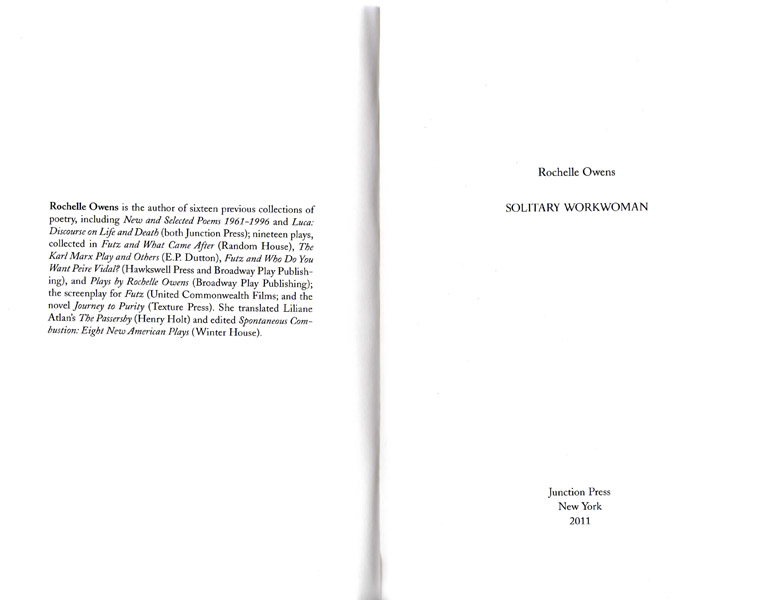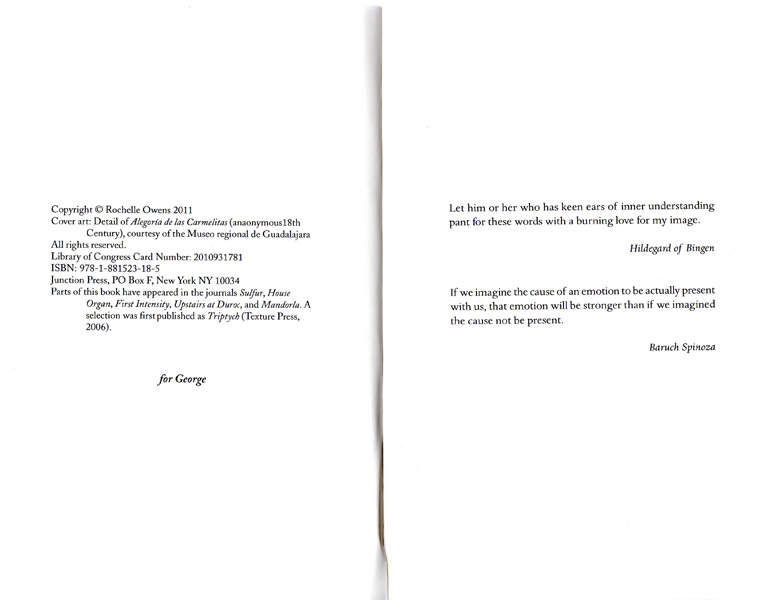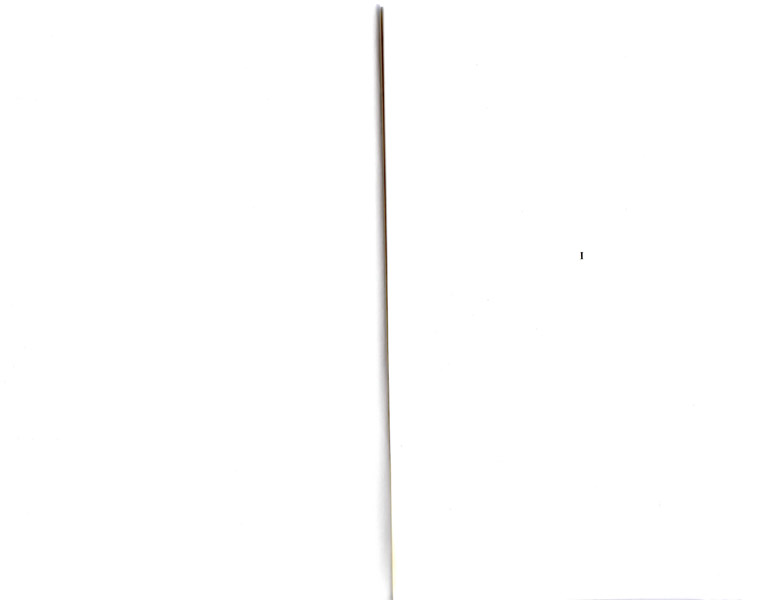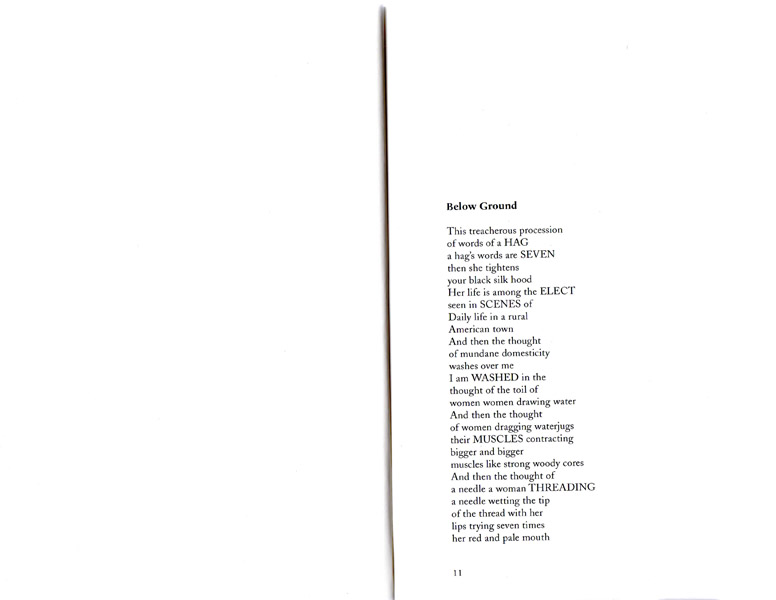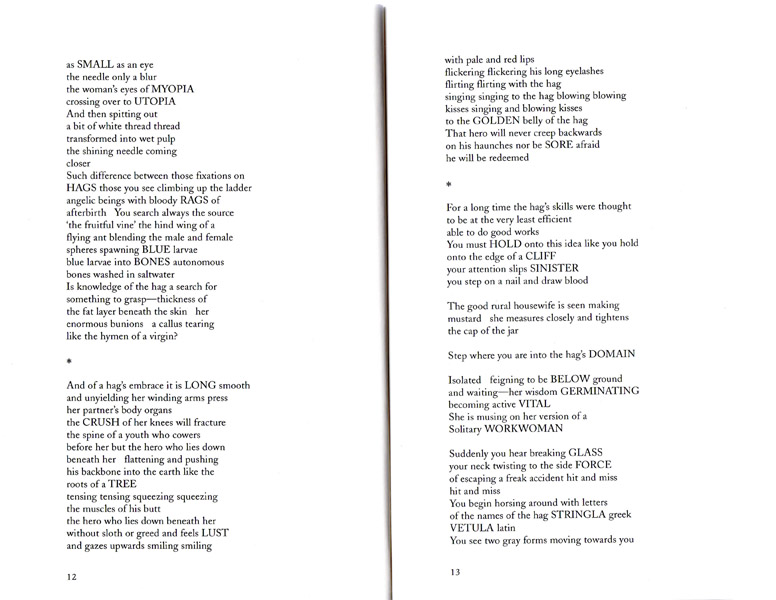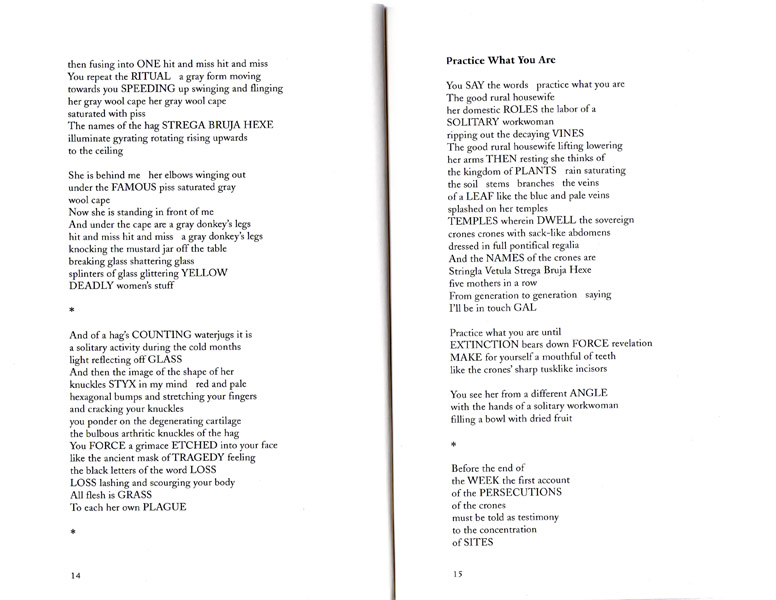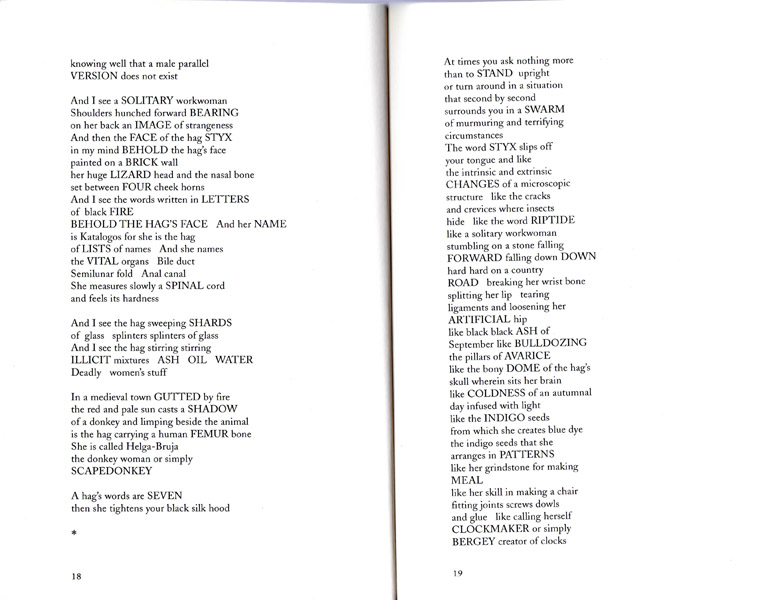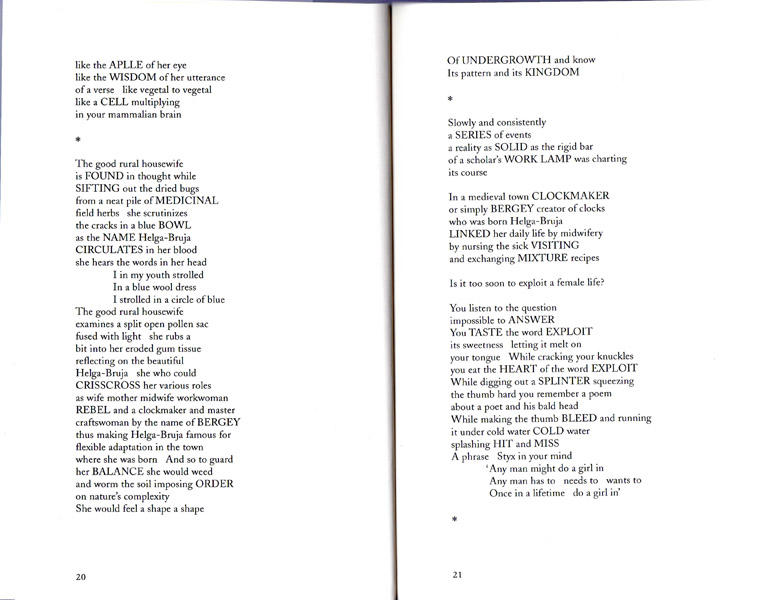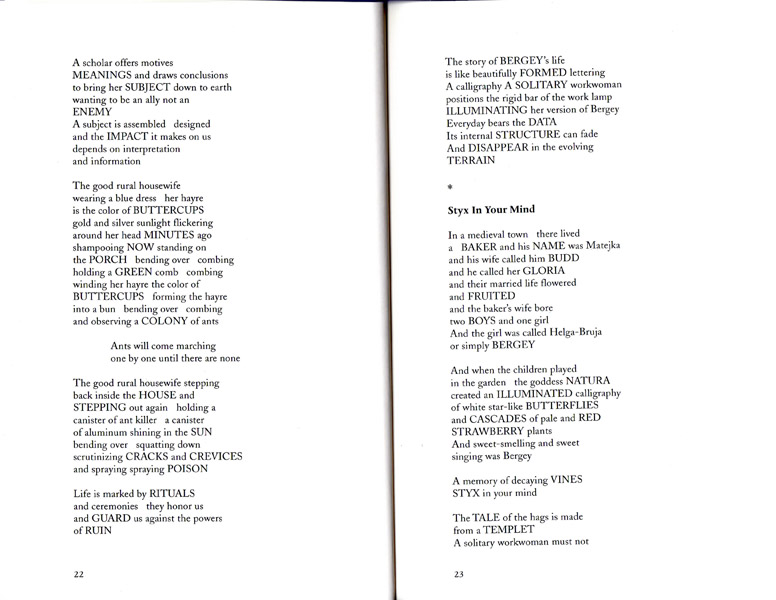Poetry Books
The Aardvark Venus: New & Selected Poems 1961-2020
Hermaphropoetics: Drifting Geometries
Out of Ur: New & Selected Poems 1961-2012
Solitary Workwoman
Luca: Discourse on Life and Death
New and Selected Poems 1961-1996
Rubbed Stones
Black Chalk
How Much Paint Does the Painting Need
W. C. Fields in French Light
Constructs
The Joe Chronicles Part 2
Shemuel
The Joe 82 Creation Poems
I Am the Babe of Joseph Stalin's Daughter
Salt and Core
Not Be Essence That Cannot Be
Solitary Workwoman
2011, Junction Press
Dramatist, exorcist, icon-smasher, prolific painter of bizarre dream worlds no more illogical than the world itself, Rochelle Owens writes poetry like nobody but nobody else. Since her comedy Futz in 1969, she has been driven to overleap boundaries and wrench conventions violently out of shape. Solitary Workwoman, a book-length poem, is the latest deployment of her highly original intuitive intelligence. It is a potent postmodern mythic vision of Everywoman constantly at work, revealed in images taken from medieval paintings and mystery plays re-animated as contemporary cinematic collage. Owens' hyper-free-associative consciousness undergoes pain, torture, spilled guts, exaltation, and surreal metamorphoses as she engages in the endless task of carrying the water of life, which is, for the poet, the task of writing.
An epigraph from the 12th-century mystic Hildegard of Bingen instructs: "Let him or her who has keen ears of inner understanding pant for these words with a burning love for my image." The poem's opening lines make clear that these are the "treacherous procession / of words of a HAG"—the hag of fairytale, witchcraft, and wisdom. Here and throughout, words are capitalized, usually arbitrarily. This blast of sound jolts the reader awake, like a radio's volume suddenly turned up by accident. Startled, you have to hear this voice of thought itself, unpunctuated, unsyntactical, repetitive as in sinister or helpful magical or religious rituals: "a hag's words are SEVEN / then she tightens your black silk hood."
The executioner's hood-cum-nun's veil recurs in the text as warning, disguise, protection, chorus, and scene-changer for the shape-shifting workwoman. She is the witch Helga-Bruja, the loathly lady, Lucy the 3.2-million-year-old proto-human, the scholar, the good rural housewife, the female figure in a gray cloak or twirling blue wool skirt, the housekeeper who watches the water boiling. Owens' language is luxurious, gem-encrusted, over the top, fearless in revelation of desire to be reborn, to search for utopia and to face up to finding apocalypse, "ash oil scourge." Women's work is slave labor to fill a quota, the sweatshop toiler's fate, or to chop two-by-fours, or to fill garbage bags with "women's stuff," a repeated motif and echo of dismissive misogynist critics in response to the work of the woman artist.
But the poem's wildness is not art or artifice. It is a lonely dirty struggle in a destroyed landscape, but it is hopeful as well, an honorable effort, lifelong, "playing out SCENES when you in your / youth being that workwoman / who desires life and loves days / that she may see good / AND then SOFT as oil shining." I walked around my house absorbing her scripturally inflected lines and speaking them to myself: "FEAR her beneath the LAND / since morning suggests portraits / a poetry of FIRE marrying / gold and silver / FIRST her gray hayer then her / breathtaking REVOLT / you standing against sloth lust / where envy VIOLATES / like barbed wire / mouth of an old woman tasting / The Book of Psalms." Who else has a mind-sword like this, one that slits the throat of nice poetic preconceptions and draws a theological and moral revelation in the blood? I love the crazed and absolute sanity of Rochelle Owens, the solitary workwoman, and I hope others too will read, mark, learn, and digest this text—and then decide, as I have, that it's one hundred percent time to get back to work.
Over the last thirty or so years, most readers and critics have tended to cast Rochelle Owens' poetry as profoundly archetypal to the point that they say that her poetry refers to all that is numenistic, including the poetry itself, which seem to have within it a kind of force or magical guiding power, particularly as it relates to female power or creativity (her poems dealing with Leonardo da Vinci in Luca).
However, her latest collection of poem cycles, Solitary Workwoman reveals a stance that is deeply anti-archetypal. At first, the poems seem to indicate continuity with a creation myth as Owens weaves repeating phrases in brief lines that sinuously move forward and bring together a kind of word tapestry of beingness.
The narrative undermines archetype at every turn, beginning with the poem passage containing a rather goofy pun, "Styx In Your Mind," which treats the tale of medieval baker, his wife, children, and the way they sprung from the goddess Natura's fashionings in calligraphy of butterflies and strawberry plants (23). While one might expect the narrative to move back and forth from light and sweet elements to the dark, lurking and chthonic to reinforce an archetype of balance in nature, in reality, the work of creation via calligraphy is potentially problematized. Certainly the goddess seems to have made something from her work with the butterflies and flowers. However, what manifests as reality is ephemeral. The truth of appearances and of beingness is not in what you see in front of you, but is in the gaps between the stuff of reality.
The TALE of the hags is made
From a TEMPLET
A solitary workwoman must not
Falsify the ART of making a
PICTURE of her subject
And truth like GROUT is forced
Into GAPS
As one might expect, one of the prime movers in the narrative is "the hag" who lives in a medieval town, where she is referred to as "THE LOATHLY LADY" (26) as she counts waterjugs that may or may not contain water. At times, they contain "woman's stuff" (116) and they are in contact with reoccurring appearances of seven maidens.
In a purely archetypal poem series the generative acts of the hags, the seven maidens, and the solitary workwoman would either lead to new creations, or to total destruction as in the case of Kali.
However, Owens' poem series reflects an impatience with the grindingly slow and imprecise function of archetype. She reaches far beyond dream, myth, or echoed form. Owens suggests that the same "woman's stuff" in the waterjugs that acts as a catalyst for change and newly engendered life (or reality), is also deadly. The "deadly woman's stuff" could be a witches' brew, or it could also simply be a self-reflexive tool for the spinners of narrative to use to signify the push-pull of competing archetypes, and to protest an ontological constant within some bodies of work or societies, namely the oppression of women.
In contrast, Owens' poem sequence privileges the concept of work, and the constant state of becoming that is at the heart of work's (and overwork's) mesmerizing capacity to charm and to enchant. The solitary workwoman is numenistic in the sense that it could be viewed as a kind of god, but only if god were a machine and work is qualitatively evaluated by quantity (always) and rarely by quality.
From the time of her first publications Rochelle Owens has spoken with a voice that seemed to some of us—when first heard—like a fierce and unrelenting force of nature. Coming into the present her latest work—the booklength Solitary Workwoman—adds to this a remarkable sense of form unfolding and expanding in the very process of composition—in the way she picks up, then releases, and again picks up key words and images—a truly dazzling display over the near-epic length of the entire work. There is no one quite like her, as Marjorie Perloff explains in summary: "Rochelle Owens' writing ... is sui generis. She is, in many ways, a proto-language poet, her marked ellipses, syntactic oddities, and dense and clashing verbal surfaces recalling the long poems of Bruce Andrews and Ron Silliman. But Owens is angrier, more energetic, and more assertive than most of her Language counterparts, male and female, and she presents herself as curiously non-introspective. Hers is a universe of stark gesture, lightning flash, and uncompromising judgment: it is imperative, in her poetic world, to face up to the horror, even as the point of view is flexible enough to avoid all dogmatism." That Solitary Workwoman is also her most personal and tragic work is its deeper secret and well worth noting. As in her final stanzas:
The chemical energy
in the crone's brainstem becomes
heat light and SOUND And the sound
is a VOICE released by the WOOD
and her burning body
In a medieval town GUTTED by fire
the red and pale sun casts a SHADOW
of a donkey and limping beside the animal
is the hag She is called Helga-Bruja
Her quest is irregular evolving
it is a FAULTLINE
No witnesses no photographs no proof
Source: Poems and Poetics
